Amphibromus neesii
Plants perennial; usually cespitose, occasionally rhizomatous. Culms 30-150 cm tall, 1-2.5 mm thick, erect, terete to flattened, glabrous; nodes 2-4; lowest internodes not swollen. Sheaths smooth or scabridulous, ribbed; ligules 4.5-8 mm, acute to acuminate; blades 10-20(37) cm long, 2-4 mm wide, flat or involute, smooth to scabrous, abaxial surfaces scabridulous, adaxial surfaces deeply ribbed, scabrous. Terminal panicles 15-40 cm, erect, sparse, lower portion rarely partially enclosed in the uppermost sheaths; branches usually 7-14 cm, ascending or appressed, often flexuous; pedicels usually 10-20 mm. Spikelets 8-17 mm, with 2-6 florets. Glumes unequal, green, sometimes purplish in the center, with hyaline margins; lower glumes 3.5-6.5 mm, 3-5-veined; upper glumes 4.5-7.5 mm, 5-7-veined; lemmas 5-8.4 mm, 7-veined, papillose to scabrous, apices appearing constricted, 2-4-toothed, awned from the upper 2/3 - 3/4 of the lemmas, awns 14-26 mm, geniculate and twisted; paleas 8/10 – 9/10 the length of the lemmas, papillose; anthers of chasmogamous florets 1.3-2.3 mm. 2n = unknown.
Discussion
Amphibromus neesii is an Australian species that grows on floodplains and river banks, and in marshes and lagoons. It was first reported as growing in North America in 1990; examination of the voucher specimens showed them to be A. nervosus, which differs from A. neesii in having a lower lemma awn insertion. Both species are included in this treatment to help prevent future misidentification of the two species in North America.
Selected References
None.
